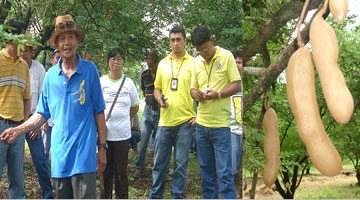 Magalang, Pampanga ─ Lahar covered Magsasaka Siyentista (MS) Oscar Baluyot’s farm and it became barren for some time. But with PCARRD’s Science and Technology-based Farm (STBF) Project, his land is now teeming with sweet tamarind.
Magalang, Pampanga ─ Lahar covered Magsasaka Siyentista (MS) Oscar Baluyot’s farm and it became barren for some time. But with PCARRD’s Science and Technology-based Farm (STBF) Project, his land is now teeming with sweet tamarind.
Tamarind (Tamarindus indica Linn.) is an important crop in some parts of the Philippines because of its varied food and medicinal uses. In the MS’s town of Magalang, the Sanguniang Bayan passed a resolution on November 23, 2007 declaring the town as the sweet tamarind capital of the Philippines. In addition, the municipality adopted sweet tamarind as its “One Town One Product” (OTOP) commodity.
Despite the potential of this crop in Pampanga, productivity remains low due to inappropriate crop management practices. MS Baluyot’s farm is an exception. He has proven that improved management practices recommended by the STBF Project ensure high yield and off-season fruit production of tamarind.
The big reveal
During a technology field day, MS Baluyot discussed the science and technology (S&T) interventions he used in his farm. These consisted of irrigating during the dry months, applying fertilizer, and pruning of unproductive branches and water sprouts.
Baluyot also revealed that it was Dr. Norman de Jesus, Vice President for Research, Development, Extension and Training of the Pampanga Agricultural College (PAC), who advised him to plant sweet tamarind. The sweet results proved the wisdom of the planting. He even observed that his sweet tamarind bore fruits three months ahead of the regular fruiting season.
Dr. Felomina Reyes, a technical expert also from PAC, explained the science behind the S&T interventions. According to her, tamarind trees start fruiting after 3─5 years from planting and yield ranges from 2.9 kg/tree to 12 kg/tree. It is estimated that 100 trees at 3kg/tree at 10m x 10m planting distance could yield as much as 300 kg/ha and earn P30,000/year.
Dr. Reyes added that the productivity of the tamarind plantation can be enhanced further by planting intercrops such as vegetables and other field crops between the rows of tamarind.
Also at the field day was Dr. de Jesus, Baluyot’s adviser. He mentioned that PAC is collaborating with the Department of Science and Technology in developing other products from sweet tamarind and in integrating honey bee keeping to enhance pollination and fruit yield performance of the trees.
Participants during the field day were officials from the municipal and agricultural offices of Magalang, City Agricultural Office of Angeles and Tarlac, and farmers from San Roque and other neighboring barangays. Also present were officials and staff from PAC, Central Luzon Agriculture and Resources Research and Development Consortium, and PCARRD.
